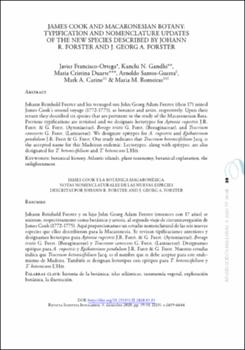James Cook and Macaronesian Botany: Typification and nomenclature updates of the new species described by Johann R. Forster and J. Georg A. Forster
Date
2020Abstract
Johann Reinhold Forster y su hijo John Georg Adam Forster (entonces con 17 años) se
unieron, respectivamente como botánico y artista, al segundo viaje de circunnavegación de
James Cook (1772-1775). Aquí proporcionamos un estudio nomenclatural de las seis nuevas
especies que ellos describieron para la Macaronesia. Se revisan tipificaciones anteriores y
designamos lectotipos para Aytonia rupestris J.R. Forst. & G. Forst. (Aytoniaceae), Borago
tristis G. Forst. (Boraginaceae) y Teucrium canescens G. Forst. (Lamiaceae). Designamos
epitipos para A. rupestris y Epibaterium pendulum J.R. Forst & G. Forst. Nuestro estudio
indica que Teucrium betonicifolium Jacq. es el nombre que se debe aceptar para este endemismo
de Madeira. También se designan lectotipos con epitipos para T. betonicifolium y
T. betonicum L’Hér. Johann Reinhold Forster and his teenaged son John Georg Adam Forster (then 17) joined
James Cook’s second voyage (1772-1775), as botanist and artist, respectively. Upon their
return they described six species that are pertinent to the study of the Macaronesian flora.
Previous typifications are revisited and we designate lectotypes for Aytonia rupestris J.R.
Forst. & G. Forst. (Aytoniaceae), Borago tristis G. Forst. (Boraginaceae), and Teucrium
canescens G. Forst. (Lamiaceae). We designate epitypes for A. rupestris and Epibaterium
pendulum J.R. Forst & G. Forst. Our study indicates that Teucrium betonicifolium Jacq. is
the accepted name for this Madeiran endemic. Lectotypes, along with epitypes, are also
designated for T. betonicifolium and T. betonicum L’Hér.





